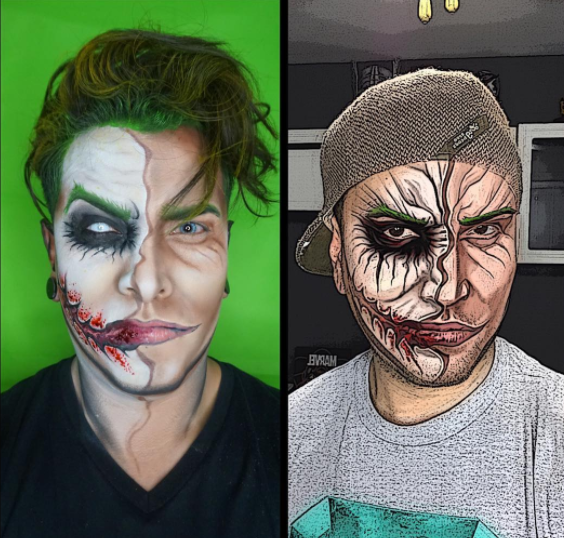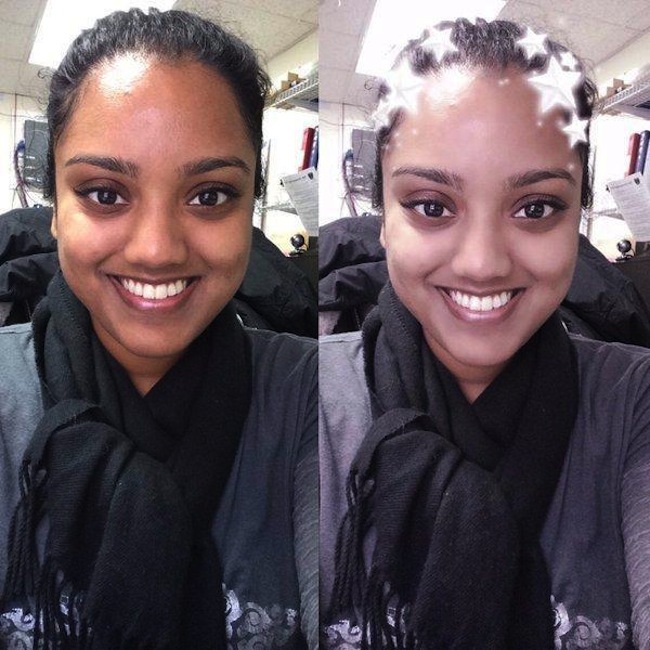Although Instagram is currently threatening to steal the 10-second story crown, there’s little doubt that this year, Snapchat was home to our most shareable moments. We captured memories, got closer to our favorite celebrities, and made our friends endure countless animated selfies. But beyond the filters, the app has served as a surprising platform for the issues and preoccupations that caught our attention in 2016. Looking back at the major conversations it sparked over 12 months, it’s clear we tackled some big questions between vomiting rainbows.
Much of the dialogue has, not surprisingly, been about appearance. Or rather, how our favorite filters speak to the way we see ourselves and each other. Some of the most obstinate opinions have centered on the popular flower crown and dog filters, which have both been criticized as “basic” and labeled “hoe filters.” Beyond the online scorn and memes they inspired, the only major correlation between the two is that they are flattering and popular with young women. Scrolling through the tweets and Instagram posts that derided them, the consensus comes to little more than that being young, female, and caring about your looks makes you a monster. Yes, this is a dumb social media joke thread that kicked around for a few weeks; but it’s also a reminder of the way we continue to police women’s behavior, and interpret any show of confidence as toxic vanity.
Y’all gonna over use that flower crown filter and turn it into the new hoe filter. Smh
— Joseph (@BunkyJoseph) April 19, 2016
Extending beyond specific designs, the controversy around filters also questioned the entire notion of a “pretty filter.” Those of us fond of a smart phone-delivered hazy glow are familiar with this clutch of options that routinely enlarge eyes, slim noses, narrow jaws, and lighten skin tones. But the universal approach to “beautifying” has faced criticism for perpetuating Western beauty ideas. After all, almost all of the changes are concerned with reinforcing Eurocentric beauty tropes.
Moving away from appearance to the designs themselves: the app faced claims from makeup artists who alleged their work had been used without their permission. Several creatives expressed concern that recent filters looked a little too similar to designs detailed in ‘How To’ YouTube tutorials. Snapchat responded to the claims by stating, “We have already implemented additional layers of review for all designs. Copying other artists isn’t something we will tolerate, and we’re taking appropriate action internally with those involved.” The platform noted that while, “the creative process sometimes involves inspiration…it should never result in copying.” Intellectual property copyright laws are universally complex and especially underdeveloped in relation to makeup artists. But while little was resolved, the dispute did enflame the ongoing conversation around the space between inspiration, theft, and coincidence.
Related: Why Snapchat is the techno-social expression of the female gaze

Across the year, the app managed to become entangled in a surprising breadth of social issues, moving far beyond appearance itself. These included the unfortunate Bob Marley incident, when a filter modeled after the late musician was employed to celebrate April 20 (4/20). While designers remain steadfast that it was intended as a salute to his legacy, it also played into the stereotype of confining Rastafarian culture to a frat-boy weed holiday. If that wasn’t problematic enough, the accompanying filter’s attempt to morph users’s faces with Marley’s created the illusion of blackface.
While nowhere near as politically incorrect, the Australian Liberal party’s awkward use of an election themed filter also drew scorn. Designed to entice younger voters, it attracted more memes than support. Many millennial voters felt put out by the thin effort to speak to them with social media ploys rather than policy.
The Liberal party Snapchat filter #fail #ausvotes CC: @PatriciaMallam pic.twitter.com/qykSASk9rG
— Kapil (@KapilJekishan) July 4, 2016
But most troublingly, the whole app became embroiled in a discussion over human right violations when Amnesty International criticized Snapchat for its failure to employ privacy protections. The organization argued that when sharing your image with friends, you’re also making your personal information easily accessible to “cybercriminals and spying by state authorities.” Not only are these risks not made clear to users, but Snapchat was criticized for not being active in protecting the data made available to them.
To be clear, though, 2016 hasn’t been all bad; there are highlights beyond the deer filter. Snapchat emerged as a new platform for creatives to experiment and be discovered, with several independent filmmakers attracting attention and production deals when their short snap-films went viral. Most impressively was Sickhouse, which was picked up by Indigenous Media to become the first made-for-mobile movie to be released as a feature film. Creator Hannah Macpherson is still in her teens.
Beyond entertainment, many companies and individuals have managed to use the app in truly innovative ways, improving lives and bringing services to individuals who may have previously been lacking them. The India based domestic violence support group Snap Counselors recognized the short-video design as a way to offer ultra private micro-counseling sessions to vulnerable individuals who were struggling to seek help. The format, that deletes videos once they’re played, offered a surprising solace for people whose privacy might otherwise be compromised by a partner or parent checking their phone regularly.
Across a mixed year, one thing is clear: the app proved it was more than a hot-bed of boredom-fueled narcissism. It was another weapon in our growing arsenal of ways to express ourselves. And like any powerful creation it needs to be handled with care, but also recognized for the power it can wield, and the damage it can do. But seriously, how good is the deer filter?
Credits
Text Wendy Syfret
